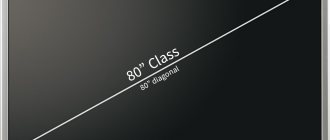The diagonal size is one of the important characteristics of any screen. Let's determine how to find out the diagonal of a computer or laptop monitor. Since this part of the technique is presented in the shape of a rectangle, the diagonal is the measurement from one corner to the other opposite it. It is calculated in inches.
How to find out the diagonal?
Sometimes you come across round or oval screens, then the indicator is taken as a line running between the points that are farthest from each other, which are opposite. Let's find out how to calculate how many inches there are in a monitor.
What is the diagonal of a monitor measured in?
A monitor is a device that is designed to display information in text or graphic mode. More often it is used to display data on the screen.
Let's find out how the diagonal of the display is measured. An inch is a unit of length. Converted to centimeters, the value is 2.54.
Has the designation ″.
Computer monitor diagonal
The most common monitor indicators are:
- computer screen – 17″, 19″, 21″, 23″ (inches);
- TV – 32″, 43″, 49″, 50″, 55″, 65″ (inches);
- smartphone, mobile phone, tablet – 4″, 3.5″, 5″, 5.5″ (inches);
- laptop monitor – 13.3″, 15.6″, 17″, 19″ (inches).
Some developers show cunning when they indicate one of the listed indicators on a large label, and in small letters introduce an amendment, usually downward, not in favor of the buyer. This is done deliberately in order to save money and reduce production costs for the development of equipment.
We present the most common indicators in terms of centimeters:
- 11 inches – 27.94 cm;
- 15.6 – 39.5 cm;
- 17 – 43.18 cm;
- 19 – 48.26 cm.
Computer or laptop monitor settings
Find out your screen resolution by visiting the web page (For all versions of Windows)
This method can be considered the simplest, but it may not be suitable for some computer configurations. All you need to do to find out your screen resolution online is open your favorite web browser and visit a page that automatically recognizes your screen resolution. A good example of such a page is whatsmyscreenresolution.com. When you go to it, the first thing you will see is the screen resolution that is recognized by the web page.
A way to find out screen resolution using a web page
Other display characteristics
When finding out the screen size, it is recommended to write down other important display parameters somewhere. Let's look at the most basic of them:
- The aspect ratio of the monitor is a parameter that shows what the ratio of height and width is in the frame. This concept applies not only to computer technology, but also to cinema in general. There are such ratios as “4:3”, “3:2”, “16:9”.
- The resolution of the monitor matrix shows how many elements of the growth image are available per unit of display area.
- Pixel density (ppi) – this parameter shows how many pixels are located per measured unit. In our case, this is an inch. For example, a MacBook has 72 pixels per inch.
Steps
Part 1 of 2: Defining the Image Region
- 1
Measure the length of your monitor screen.
Using a ruler, measure the horizontal length of the monitor, from one end to the other. Do not include the frame or area around the monitor in your measurement, only measure the screen. X Source of information
- 2
Measure the height of your monitor screen.
Measure only the image area, not the frame or border around the monitor. Use a ruler to determine the vertical height, from top to bottom. X Source of information
- 3
Multiply the length by the height.
To determine the image area, multiply the monitor's height by its length. Express the image area using the formula "horizontal length x vertical height". X Source of information
For example, if the length is 16 inches (40.5 cm) and the height is 10 inches (25.4 cm), then the image area can be found by multiplying 16 by 10, which equals 160 inches (406.4 cm).
Part 2 of 2: Determining Aspect Ratio and Diagonal Size
- 1
Determine the aspect ratio by comparing the length and height.
Computer monitors usually have aspect ratios of 4:3, 5:3, 16:9 or 16:10. To find out the aspect ratio, express the ratio of length and height as a fraction and, if necessary, reduce the fraction. X Source of information
- If the length is 16 inches (40.6 cm) and the height is 10 inches (25.4 cm), then the aspect ratio will be 16:10.
If the length is 25 inches (63.5 cm) and the length is 15 inches (38.1 cm), then the aspect ratio will be 25:15. The fraction can be reduced by 5 to get a ratio of 5:3.
- 2
Measure the distance between opposite corners to find the diagonal.
The size of a monitor usually refers to the size of its diagonal. Use a tape measure or ruler to find the distance, for example, from the top left corner of the screen to the bottom right corner of the screen. Do not include the bevel or frame around the screen in your measurement. X Source of information
- 3
Use the Pythagorean theorem to determine the diagonal distance.
If the screen is too large to measure diagonally or you don't want to get it dirty, use the Pythagorean Theorem to determine the diagonal distance. Take the values of the squares of the height and width of the screen, add them and then take the square root of the resulting sum, which will be the diagonal value. X Source of information
For example, if the height is 10 inches (25.4 cm), multiply it by itself (10x10=100). Then multiply the length, 16 inches (40.6 cm), by itself (16x16=256). Add these two numbers together (100+256=356), then find the square root of the sum (√356=18.9).
- You can also find out the monitor size from the monitor model number on the manufacturer's website or through a search site.
For players
Working on a monitor with a vertical scan frequency of 60 and 120 Hz are two big differences. Well, for those who mainly play on the computer - even more so.
Contender: LG 34UC79G.
The most real gaming solution in the segment of UWFHD solutions with almost the maximum diagonal for it - and it has only just recently been sold. The monitor is lost in the wide range of the manufacturer, little is said about it, but this does not make it lose its relevance. When compared with 35-inch *VA models with the same resolution, the IPS version from the Koreans, with an increased vertical scanning frequency to 144 Hz and support for AMD FreeSync, definitely beats them in speed, which you will also get without obvious artifacts Pictures.
Average price: 45,000 rubles.
Why you should buy: a huge, 34-inch curved beauty with a good IPS gaming panel, high-quality build, materials and support for AMD FreeSync.
What can stop it: deep stand, low backlight uniformity on black.
Using the AIDA64 program
If you don’t have a ruler at home, you can use software. Install the AIDA64 program on your laptop. This program scans the computer and displays all technical characteristics, including display diagonal. AIDA64 is a paid utility, but demo access is available for 30 days. A month is definitely enough to do the following:
- Launch AIDA64. Go to the "Display" tab and select "Monitor".
- In the “Monitor type” line, look at the size in inches.
The window will also contain a number of useful information: aspect ratio, maximum resolution, frame rate, even release date. Therefore, in terms of information content, there is nothing better than the AIDA64 program.
We recommend
Monitors
TV diagonal: what is it, how to find out what types
Asus VG278HR are Diagonal: 27″ Resolution: 1920 x 1080 Response: 2 ms Matrix: TN
HP 27f Diagonal: 27″ Resolution: 1920 x 1080 Response: 5 ms Matrix: IPS
AOC C24G1 Diagonal: 23.6″ Resolution: 1920 x 1080 Response: 1 ms Matrix: VA
Acer Nitro VG270U Diagonal: 27″ Resolution: 2560 x 1440 Response: 1 ms Matrix: AHVA IPS, AAS IPS
TVs
Xiaomi Mi TV 4S 43 Diagonal: 42.5″ Resolution: 3840 x 2160
Xiaomi Mi TV 4S 43 Diagonal: 42.5″ Resolution: 3840 x 2160
Xiaomi Mi TV 4S 50 Diagonal: 49.5″ Resolution: 3840 x 2160 Matrix: VA
Xiaomi Mi TV 4S 50 Diagonal: 49.5″ Resolution: 3840 x 2160 Matrix: VA
About the service
Usually, we need to find out the monitor resolution when we change OS settings, check compliance with the software system requirements, or simply out of curiosity.
Previously, to solve this problem you had to download special software, but now the screen resolution can be determined online right here. The method is very easy: just look at the result written in large numbers at the very top. This page will instantly determine the screen resolution of any device: personal computer, laptop, tablet, mobile phone (smartphone). The service is available free of charge and without registration.
How is the diagonal related to the size of the TV?
The diagonal is directly related to the size of the TV, since most of the device is screen space. The relationship between TV size and diagonal is an indisputable fact, since there are no bulky models with a small display. When buying a new TV, you need to take into account that the screen size must correspond to the distance from the viewing point to the location of the device. For example, if the distance is small, then it is better to give preference to a model with a small diagonal.
All necessary calculations, as well as assessment of the situation, can be carried out independently. Don't forget that the content you plan to watch matters. For example, terrestrial TV is characterized by low quality and poor detail. Today, only some channels are available to broadcast in HD. Therefore, if you do not plan to buy a satellite dish, connect cable TV, IPTV or watch movies in online cinemas, then there is no point in a large TV. All imperfections in the image will be too visible.
The larger the diagonal of the TV screen, the larger the matrix. Naturally, all this is displayed on the final size of the device.
Materials
How to measure the diagonal of a TV
Depending on the material of the slats, blinds are divided into:
Aluminum - inexpensive and practical, resistant to external influences. Do not fade over time. Thin metal panels can become deformed under mechanical stress.
Plastic is the most affordable and common material. From excess ultraviolet radiation, plastic lamellas become fragile and can break.
Fabric curtains can fully replace curtains due to the decorative nature of the panels. They are presented in different colors, plain and patterned. The fabric used is special with protective impregnation, which prevents dust from being absorbed and also protects against fading. Most often, fabric blinds are made of polyester.
Wooden or bamboo are an option for people who, first of all, value environmental friendliness in the interior. Natural color and texture will decorate rooms made in ethno, country, and neoclassical styles. Wooden panels are treated with a protective varnish to increase resistance to ultraviolet radiation and moisture.
Energy consumption, brackets and other nuances
I won't go into too much detail on this, but there are a few things to keep in mind as well.
When choosing a monitor based on size, it is important to remember that the larger the diagonal, the more energy such a device consumes
If there are several computers at home and each is equipped with a huge display, the utility bill may become an unpleasant surprise for the owner.
Naturally, the larger the monitor, the more material is required for its production and the heavier it is. The stand on which it rests must be suitable for and support the weight of the device.
The same goes for wall-mounting brackets: the larger and more massive the monitor, the stronger the bracket and connection needed to mount it on the wall.
The amount of liquid crystals used to create it affects the price. Read more about the types of monitor matrices.











